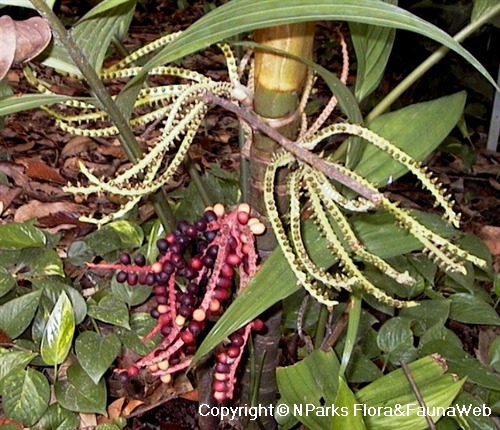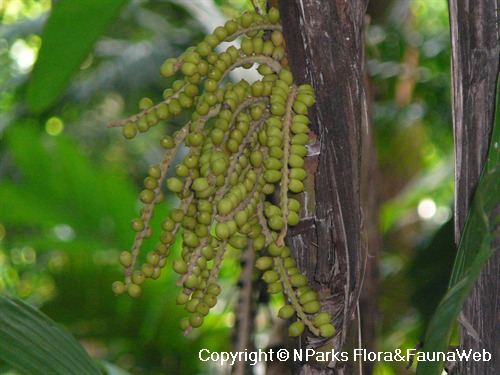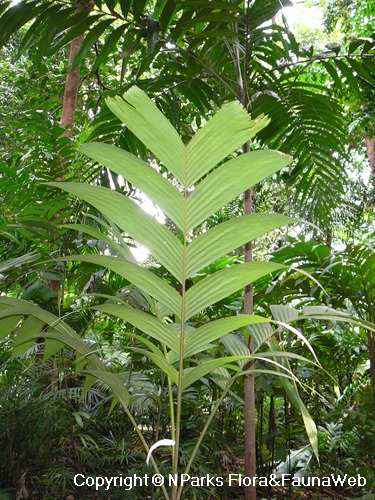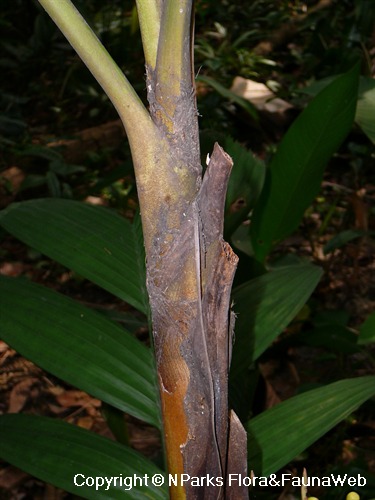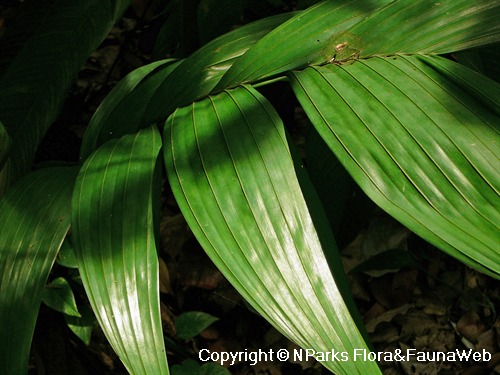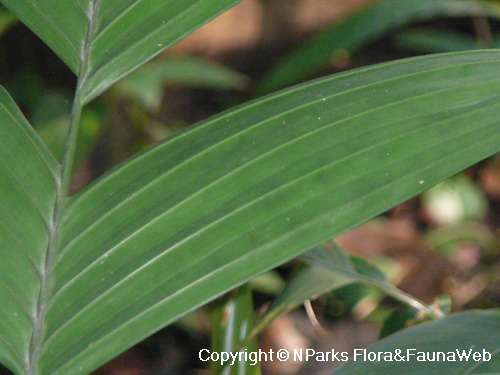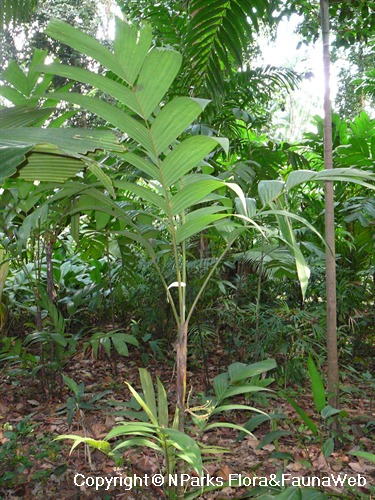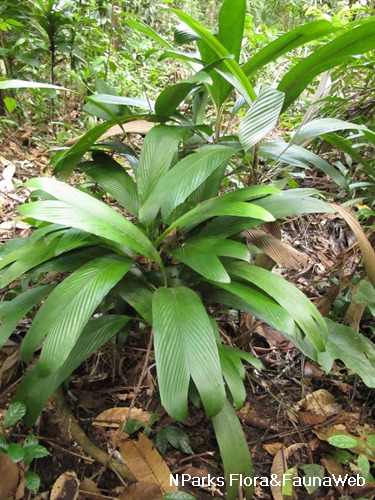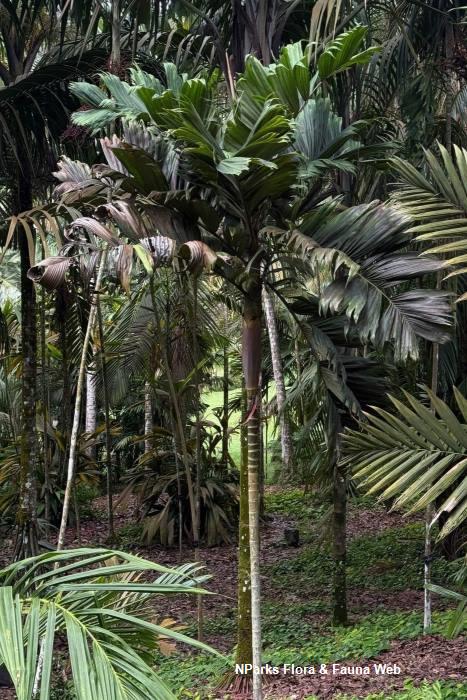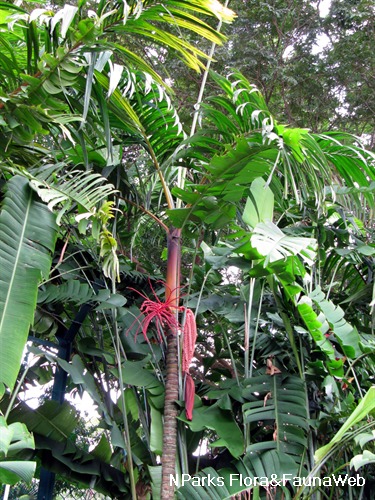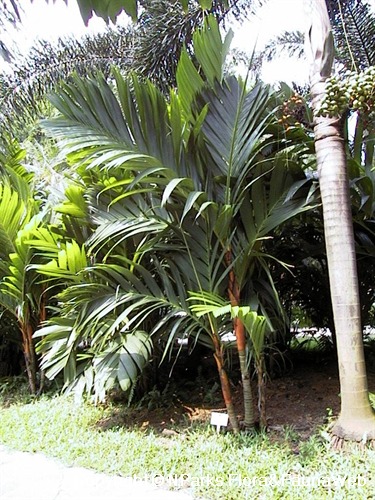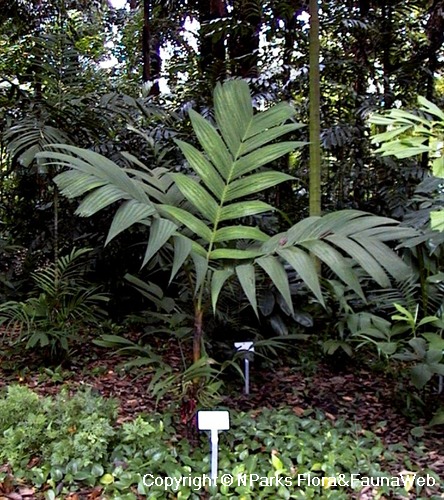
Back
Pinanga coronata (Blume) Blume
| Family Name: | Arecaceae (Palmae) |
| Synonyms: | Pinanga kuhlii Blume, Pinanga costata Blume, Pinanga noxa Blume, Pinanga sumatrana (Scheff.) H.Wendl. |
| Common Name: | Ivory Cane Palm, Kuhl's Palm, Bing-bin, Piji, Pinang Rante |
Pinanga coronata, or commonly known as Ivory Cane Palm, is a clustering palm native to Sumatra, Java and the Lesser Sunda Islands. Growing up to 11 m tall, the palm produces slightly mottled, even-pinnately compound fronds with irregular groups of leaflets. The species is highly variable in form.
Name
Classifications and Characteristics
| Plant Division | Angiosperms (Flowering Seed Plants) (Monocotyledon) |
|---|---|
| Plant Growth Form | Palm (Clustered Habit) |
| Lifespan (in Singapore) | Perennial |
| Mode of Nutrition | Autotrophic |
| Maximum Height | 3.5 m to 11 m |
Biogeography
| Native Distribution | Sumatra, Java, & Lesser Sunda Islands |
|---|---|
| Native Habitat | Terrestrial (Primary Rainforest, Mountain) |
| Preferred Climate Zone | Highland / Montane, Tropical |
| Local Conservation Status | Non-native (Horticultural / Cultivated Only) |
Description and Ethnobotany
| Growth Form | It is a clustering palm, growing up to 3.5–11 m tall. |
|---|---|
| Trunk | The trunk is erect and green to brownish-green, measuring about 2–8 (10) m tall × 1.5–7 (10) cm in diameter, and ringed with evenly spaced leaf scars. |
| Foliage | The fronds are large (1.5–3 m long, including leaf sheath) and even-pinnately compound. A single frond holds 6–30 pairs of smooth, irregularly-fused leaflets, each about 32–90 cm long × 0.8–9 cm wide (apical & basal leaflets are slightly smaller) with 1–7 ribs. The rachis (midrib of a compound leaf) is 0.9–1.8 m long, and the petiole is 0.2–1 m long. Both rachis and petiole are either smooth or covered with silvery scales below. Developing fronds are bronze to purple, eventually turning mottled green. |
| Crown Shaft | The crown shaft is elongated and swollen, measuring up to 1 m in length. It can be green, yellowish, or brownish-green, or browish to reddish yellow in mature plants, covered in brown scales. |
| Flowers | The inflorescence is pendulous or erect then pendulous and infrafoliar (borne below the fronds and/or crownshaft), pendulous, and subtended by a persistent spathe or peduncular bract. It branches up to 1 order with 5–22 deflexed rachillae (minor, secondary axes on inflorescences), each about 9 - 14 cm long. The inflorescence is green when young, eventually turning yellow-pink to red. Triads of one female flower flanked by two male flowers occur distichously (in two opposite rows) throughout the length of the rachillae. Male flowers are creamy-white with 12–16 (28) stamens. |
| Fruit | The fruit is a smooth, oval drupe (a fleshy fruit with thin skin and a single central seed), up to 11–15 mm long × 6–10 cm wide. They ripen to yellow-pink, red to brownish-red. The single seed is oval, 7.5–12 mm long x 5–7 mm wide. |
| Habitat | It can be found on very steep hillsides in montane forest and flat areas in lowland forest, up to 1800 m above sea level. |
| Taxonomy | This species is highly variable in morphology, but two forms are generally accepted. The 'standard' highland form grows well in full sun, holds regularly pinnately-compound leaves when mature, and is not as mottled as the lowland form (previously P. kuhlii). The lowland form requires shelter from the sun and is intolerant of cold weather.P. costata and P. noxa have been reduced to P. coronata due to similar characteristics that are indistinguishable in the field. |
| Cultivation | It grows best in moist, well-drained soil in full sun or semi-shade. It can be propagated by seed. |
| Etymology | The genus Pinanga is derived from the Malay vernacular name, Pinang, for the Betel Nut Palm (Areca catechu). The specific epithet coronata is Latin for 'crown', possibly referring to the dense growth habit. |
Landscaping Features
| Desirable Plant Features | Ornamental Form, Ornamental Foliage |
|---|---|
| Landscape Uses | Parks & Gardens, Hedge / Screening |
| Thematic Landscaping | Bird & Wildlife Garden |
Fauna, Pollination and Dispersal
| Pollination Method(s) | Biotic (Fauna) (Insects (Ant, Beetle, Fly, Thrip, Wasp), Insects (Bee)) |
|---|
Plant Care and Propagation
| Light Preference | Semi-Shade, Full Sun |
|---|---|
| Water Preference | Moderate Water |
| Plant Growth Rate | Fast to Moderate |
| Rootzone Tolerance | Fertile Loamy Soils, Well-Drained Soils, Moist Soils |
| Propagation Method | Seed |
Foliar
| Foliage Retention | Evergreen |
|---|---|
| Mature Foliage Colour(s) | Green, Patterned |
| Mature Foliage Texture(s) | Smooth |
| Prominent Young Flush Colour(s) | Brown, Purple |
| Foliar Type | Simple / Unifoliate |
| Foliar Arrangement Along Stem | Spiral |
| Foliar Attachment to Stem | Petiolate |
| Foliar Shape(s) | Palm Fronds (Pinnate / Feather) |
| Foliar Venation | Parallel |
| Foliar Margin | Entire |
| Leaf Area Index (LAI) for Green Plot Ratio | 4.0 (Palm - Cluster) |
Non - Foliar and Storage
| Trunk Type (Palm) | Aboveground, Clustering Habit |
|---|---|
| Root Type | Underground (Fibrous Root) |
Floral (Angiosperm)
| Flower & Plant Sexuality | Unisexual Flowers , Monoecious |
| Flower Colour(s) | Cream / Off-White |
|---|
| Flower Texture(s) | Smooth |
| Flower Grouping | Cluster / Inflorescence |
| Flower Location | Cauliflorous |
| Inflorescence Type | Panicle |
| Ovary Position | Superior / Hypogynous |
| Flowering Habit | Polycarpic |
Fruit, Seed and Spore
| Mature Fruit Colour(s) | Pink, Red, Yellow / Golden |
|---|---|
| Mature Fruit Texture(s) | Smooth |
| Fruit Classification | Simple Fruit |
| Fruit Type | |
| Mature Seed Colour(s) | Black |
| Seed Quantity Per Fruit | Few (1-5) |
References
| References | Pinanga coronata (Blume ex Mart.) Blume. Palmweb: Palms of the World Online. https://www.palmweb.org/cdm_dataportal/taxon/0568ee82-9d8b-4ecf-b619-a109f3eb362f (Accessed on 14 November 2025) |
|---|
Image Repository
Others
| Master ID | 1375 |
|---|---|
| Species ID | 2668 |
| Flora Disclaimer | The information in this website has been compiled from reliable sources, such as reference works on medicinal plants. It is not a substitute for medical advice or treatment and NParks does not purport to provide any medical advice. Readers should always consult his/her physician before using or consuming a plant for medicinal purposes. |

